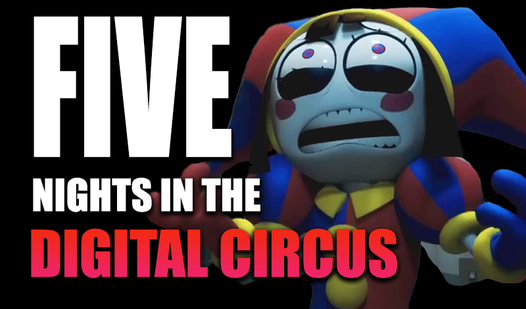Exit 8
Related![Five Nights at Freddy's 2]() Five Nights at Freddy's 2
Five Nights at Freddy's 2![Five Nights at Freddy's]() Five Nights at Freddy's
Five Nights at Freddy's![Katnap. Survival and morphs]() Katnap. Survival and morphs
Katnap. Survival and morphs![Baldi]() Baldi
Baldi![Granny Original]() Granny Original
Granny Original![Amanda the adventurer]() Amanda the adventurer
Amanda the adventurer![Five Nights in the Digital Circus]() Five Nights in the Digital Circus
Five Nights in the Digital Circus![Poppy Playtime Chapter 1 - Huggy Wuggy]() Poppy Playtime Chapter 1 - Huggy Wuggy
Poppy Playtime Chapter 1 - Huggy Wuggy![Granny 3 Original]() Granny 3 Original
Granny 3 Original![Granny 2 Original]() Granny 2 Original
Granny 2 Original![War V: Path of the Survivor!]() War V: Path of the Survivor!
War V: Path of the Survivor!![Schoolboy Escape: Stealth Runaway]() Schoolboy Escape: Stealth Runaway
Schoolboy Escape: Stealth Runaway![Poppy Playtime Chapter 2 - Huggy Wuggy]() Poppy Playtime Chapter 2 - Huggy Wuggy
Poppy Playtime Chapter 2 - Huggy Wuggy![Rise of the Dead]() Rise of the Dead
Rise of the Dead![FNAF - Animatronic Simulator]() FNAF - Animatronic Simulator
FNAF - Animatronic Simulator![UCN - Ultimate Custom Night]() UCN - Ultimate Custom Night
UCN - Ultimate Custom Night
 Five Nights in the Digital Circus
Five Nights in the Digital CircusExit 8
Developer: DarkPlay
Platforms: iOS, Android, PC
About the exit 8 game?
Exit 8 plunges into the eerie depths of a subway station. This walking simulator immerses players in a labyrinthine network of underground passages, where the corridors seem endless, and a lone passenger walks the same path over and over again, creating an unsettling atmosphere. Moving through this ghostly environment, the player must be vigilant and watch for anomalies, and the player must urgently turn around if something seems unusual. The game creates a realistic and exciting environment that enhances the overall feeling of anxiety.Recommended![Noob: Obby on a Bike]() Noob: Obby on a Bike
Noob: Obby on a Bike![Battle of the red and blue agents]() Battle of the red and blue agents
Battle of the red and blue agents![TABS]() TABS
TABS![Idle Train Empire Tycoon]() Idle Train Empire Tycoon
Idle Train Empire Tycoon![Crazy Motorcycle]() Crazy Motorcycle
Crazy Motorcycle![Geometry Arrow]() Geometry Arrow
Geometry Arrow![Geometry Arrow 2]() Geometry Arrow 2
Geometry Arrow 2![Race Survival: Arena King]() Race Survival: Arena King
Race Survival: Arena King![Obby but You're on a Bike]() Obby but You're on a Bike
Obby but You're on a Bike![Mega Ramp Stunt]() Mega Ramp Stunt
Mega Ramp Stunt![Noob Miner 2: Escape from Prison]() Noob Miner 2: Escape from Prison
Noob Miner 2: Escape from Prison![Ball Sort Puzzle]() Ball Sort Puzzle
Ball Sort Puzzle![Draw Joust!]() Draw Joust!
Draw Joust!![Melon Sandbox]() Melon Sandbox
Melon Sandbox![Obby: Easy Parkour]() Obby: Easy Parkour
Obby: Easy Parkour![Zombie Space Episode II]() Zombie Space Episode II
Zombie Space Episode II
Random![Biomons Mart.]() Biomons Mart.
Biomons Mart.![Mini Games - Italian Brainrot Animals Tralalero]() Mini Games - Italian Brainrot Animals Tralalero
Mini Games - Italian Brainrot Animals Tralalero![Stock Exchange Simulator]() Stock Exchange Simulator
Stock Exchange Simulator![Bear Adventure]() Bear Adventure
Bear Adventure![Bonbon Monsters]() Bonbon Monsters
Bonbon Monsters![Merge To Explode]() Merge To Explode
Merge To Explode![The Utans]() The Utans
The Utans![Critical Strike CS: FPS Commando]() Critical Strike CS: FPS Commando
Critical Strike CS: FPS Commando![3D Coloring - Clear the Snow]() 3D Coloring - Clear the Snow
3D Coloring - Clear the Snow![Vega Mix 2]() Vega Mix 2
Vega Mix 2![Schedule 1 - Kill Them All]() Schedule 1 - Kill Them All
Schedule 1 - Kill Them All![Cute cat's adventures]() Cute cat's adventures
Cute cat's adventures![Geometry Pencil]() Geometry Pencil
Geometry Pencil![Clicker: Shark]() Clicker: Shark
Clicker: Shark![Color Rings]() Color Rings
Color Rings![Amass The Boxes Game]() Amass The Boxes Game
Amass The Boxes Game
Free Online Games at Playgama
Playgama features the latest and best free online games. You can enjoy playing fun games without interruptions from downloads, intrusive ads, or pop-ups. Just load up your favorite games instantly in your web browser and enjoy the experience.
